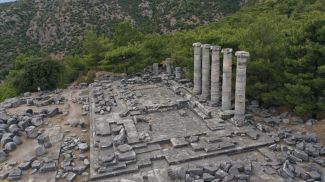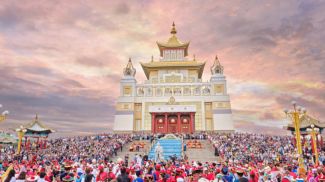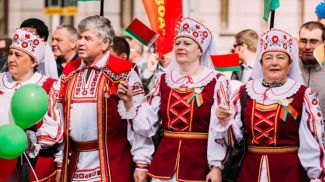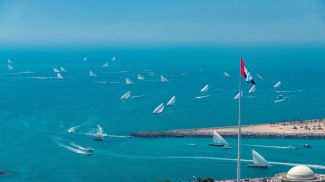
BEIJING, 20 December (BelTA - People's Daily Online) - Central China's
Henan Province boasts rich historical and cultural resources associated
with the Yellow River. By tapping into these treasures and embracing
innovation, Henan has rolled out new ideas, scenarios, and experiences
themed on the Yellow River culture.
Along the Yellow River in Henan, there are over 200 museums and heritage sites that serve as windows for people to understand the Yellow River culture. Data shows that from January to July this year, museums in Henan received over 42.6 million tourist visits.
During this year's National Day holiday in early October, the top five scenic areas that received the most tourist arrivals in Henan were all situated in cities along the Yellow River. The Yellow River cultural tourism belt has truly emerged as the most prominent and dynamic region within Henan's cultural and tourism sector.
Huang Dongsheng, director of the Culture and Tourism Department of Henan Province, said Henan is planning to construct a tourism road spanning approximately 4,810 kilometers. This road will connect 38 popular scenic areas and 46 lesser-known but equally captivating spots along the Yellow River.
Major cities in the province, like Luoyang and Zhengzhou, are also doing their part to improve the experience for tourists.
During the holidays, Li Xinmin goes all out with makeup. As a Hanfu makeup artist in Luoyang, she regularly receives dozens of tourists daily during peak season. In the past, the city saw its peak tourism season in just one month when its peony flowers bloomed. Nowadays, it receives tourists throughout the year. "I feel that Luoyang has a richer cultural atmosphere nowadays, with people wearing Hanfu commonly seen on the streets, and the presence of more interesting museums," said a local citizen.
By promoting tourism through its rich cultural heritage, Luoyang has enhanced the depth of travel experiences for visitors. The integration of culture into the tourism industry has drawn tourists to Luoyang even during off-peak seasons.
After learning about the immersive theater complex "Unique Henan: Land of Drama" on a video platform, Chen Jie was captivated and immediately traveled to Zhengzhou, the provincial capital of Henan, to attend a play. The theater at Zhengzhou Railway Station left a lasting impression on her. Inspired by this experience, she made the decision to further explore the cultural treasures of Henan.
"Unique Henan: Land of Drama" consists of 21 theaters. Offering shows with a total length of nearly 700 minutes, it encapsulates the rich culture of the Yellow River and Central Plains. From January to November this year, the complex attracted more than 20 million tourist visits, with over 70 percent of them hailing from outside the province. Notably, 85 percent of the audience members were born after 1985.
Henan has established a database of Yellow River cultural heritage resources, identifying 947 provincial-level and above intangible cultural heritage projects, as well as 488 major cultural heritage sites. Seven national archaeological site parks have been built, creating a world-class heritage site protection corridor along the Yellow River. Additionally, nine national-level and 55 provincial-level nighttime cultural and tourism consumption zones have been established along the Yellow River.
Along the Yellow River in Henan, there are over 200 museums and heritage sites that serve as windows for people to understand the Yellow River culture. Data shows that from January to July this year, museums in Henan received over 42.6 million tourist visits.
During this year's National Day holiday in early October, the top five scenic areas that received the most tourist arrivals in Henan were all situated in cities along the Yellow River. The Yellow River cultural tourism belt has truly emerged as the most prominent and dynamic region within Henan's cultural and tourism sector.
Huang Dongsheng, director of the Culture and Tourism Department of Henan Province, said Henan is planning to construct a tourism road spanning approximately 4,810 kilometers. This road will connect 38 popular scenic areas and 46 lesser-known but equally captivating spots along the Yellow River.
Major cities in the province, like Luoyang and Zhengzhou, are also doing their part to improve the experience for tourists.
During the holidays, Li Xinmin goes all out with makeup. As a Hanfu makeup artist in Luoyang, she regularly receives dozens of tourists daily during peak season. In the past, the city saw its peak tourism season in just one month when its peony flowers bloomed. Nowadays, it receives tourists throughout the year. "I feel that Luoyang has a richer cultural atmosphere nowadays, with people wearing Hanfu commonly seen on the streets, and the presence of more interesting museums," said a local citizen.
By promoting tourism through its rich cultural heritage, Luoyang has enhanced the depth of travel experiences for visitors. The integration of culture into the tourism industry has drawn tourists to Luoyang even during off-peak seasons.
After learning about the immersive theater complex "Unique Henan: Land of Drama" on a video platform, Chen Jie was captivated and immediately traveled to Zhengzhou, the provincial capital of Henan, to attend a play. The theater at Zhengzhou Railway Station left a lasting impression on her. Inspired by this experience, she made the decision to further explore the cultural treasures of Henan.
"Unique Henan: Land of Drama" consists of 21 theaters. Offering shows with a total length of nearly 700 minutes, it encapsulates the rich culture of the Yellow River and Central Plains. From January to November this year, the complex attracted more than 20 million tourist visits, with over 70 percent of them hailing from outside the province. Notably, 85 percent of the audience members were born after 1985.
Henan has established a database of Yellow River cultural heritage resources, identifying 947 provincial-level and above intangible cultural heritage projects, as well as 488 major cultural heritage sites. Seven national archaeological site parks have been built, creating a world-class heritage site protection corridor along the Yellow River. Additionally, nine national-level and 55 provincial-level nighttime cultural and tourism consumption zones have been established along the Yellow River.













